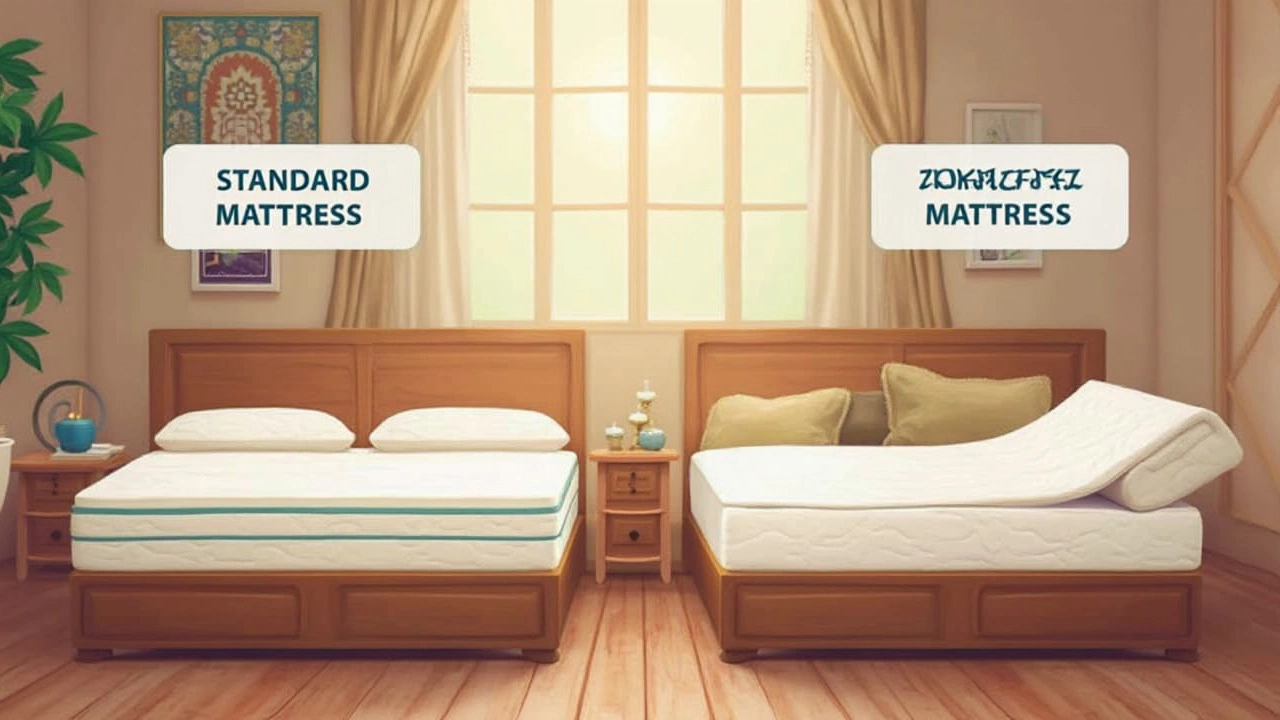If you’ve ever tried to haul an old, saggy mattress out of a bedroom, you know just how much your body relies on a decent bed—especially as you age. But here’s the kicker: Medicare doesn’t just hand out mattresses to anyone on a whim. Regular mattresses sold at big-box stores don’t count, no matter how tough your back pain is. Medicare only considers helping with mattresses if they count as durable medical equipment. Think medical-grade stuff—like pressure-relief mattresses for folks with serious health needs.
This is where most people get tripped up. If your doctor says you need a special mattress because you’re at risk for pressure sores, or you already have them, you might stand a chance. Medicare has rules about exactly what kind of mattress they’ll help pay for, and there’s a whole process to get approved. If you’re just hoping for a plush upgrade, sorry—it doesn’t work like that.
- What Kinds of Mattresses Does Medicare Ever Cover?
- Who Qualifies for Mattress Coverage?
- How to Get Medicare to Pay (If You Qualify)
- Mattress Choices—What’s Actually Covered?
- Simple Tips When Buying a Mattress as a Senior
What Kinds of Mattresses Does Medicare Ever Cover?
Medicare isn't in the business of paying for just any sleep upgrade. Standard beds and soft, supportive mattresses you see in stores? Not covered. Medicare will only consider paying for a mattress if it's what's called "durable medical equipment" (DME). We're talking about specialized mattresses, usually for people who are bedridden or at risk of pressure ulcers—sometimes called bedsores.
So, what counts? Here are the main types:
- Pressure-reducing mattresses or overlays: These reduce the risk of skin breakdown for people stuck in bed for long stretches. Air-fluidized beds and alternating pressure mattresses are actually the most common types approved.
- Low air loss mattresses: These constantly pump air to keep the skin dry and reduce pressure. Think of them as next-level support for people with serious mobility issues.
- Alternating pressure pads with pumps: These pads slowly change the pressure on different parts of the body on a cycle, which helps prevent sores from staying in one spot.
But here’s the key: Medicare covers these only when they're prescribed for a medical reason—like after surgery, a serious illness, or chronic conditions that make turning in bed tough or impossible. Ordinary memory foam or hybrid models you’d use just for comfort don’t count as DME.
For a clearer picture, here’s a quick table showing what Medicare may cover versus what’s totally out of bounds:
| Mattress Type | Covered by Medicare? | Main Reason |
|---|---|---|
| Standard Innerspring or Memory Foam | No | Considered non-medical, for personal comfort |
| Alternating Pressure Mattress | Yes | Treats or prevents pressure sores |
| Low Air Loss Mattress | Yes | Helps at-risk patients manage skin moisture and pressure |
| Gel or Egg Crate Mattress Overlay | Sometimes | May be covered if proven medically necessary |
| Adjustable Beds (for comfort only) | No | Not considered medical equipment |
The takeaway: unless your mattress is prescribed to treat or prevent a real medical problem, Medicare’s probably not picking up the tab. If you need one of these special mattresses, you’ll need a prescription and approval before they’ll pitch in for the cost.
Who Qualifies for Mattress Coverage?
This is the first thing people ask: Do I even have a shot at getting Medicare to cover a mattress? Here’s the straight talk. Medicare isn’t in the business of buying ordinary beds. They only pitch in if you need a Medicare approved medical mattress due to a health problem, not just aging joints or trouble sleeping.
To qualify, you need to meet these clear-cut standards:
- You have Medicare Part B (medical insurance), which covers durable medical equipment (DME) like certain qualifying mattresses.
- Your doctor must prescribe the mattress as medically necessary. It’s not just about being more comfortable—there needs to be a legit health reason, like being at risk for or having pressure ulcers (bed sores).
- The mattress has to be the kind Medicare recognizes as DME: alternating pressure mattresses, pressure-reducing beds, or specialized overlays.
- Your supplier must be enrolled in Medicare and accept assignment for the cost.
Here’s a simple table to break down when you might qualify:
| Qualification Factor | Needed for Coverage |
|---|---|
| Doctor's Prescription | Required |
| Specific Medical Condition | Yes (like risk of pressure sores) |
| Medicare-enrolled Supplier | Required |
| Type of Mattress | Medical-grade only (not regular beds) |
As the Medicare.gov site says—
"Medicare covers pressure-reducing beds and mattresses if you meet certain medical conditions. Regular beds or mattresses aren’t covered just for comfort."
If you’re only dealing with some backaches, Medicare won’t help with a mattress. But for someone who’s getting home care after surgery or at risk for skin breakdown, that prescription from an actual doctor is your ticket to the process. So don’t skip the doctor visit or try to buy first and claim later. That’s just money out of your pocket.

How to Get Medicare to Pay (If You Qualify)
If you think Medicare might help with the cost of a mattress, don’t just run out and buy one. First, your doctor needs to say that you need a special kind of mattress due to a real medical reason—something like being at risk for pressure sores or spending most of your day in bed. This can’t just be based on comfort; Medicare wants proof it’s for your health.
You’ll need a written prescription from your doctor. This is step one. The doctor should state exactly why you need a medical mattress and specify the type you need—like an alternating pressure mattress or pressure-reducing overlay. Make sure the doctor understands the rules, since Medicare won’t help if the paperwork’s wrong or too vague.
- Ask your doctor or nurse to submit the Medicare claim for you. The supplier where you’ll get the mattress (think medical supply company, not mattress store) must also be contracted with Medicare, or you’ll get stuck paying it all yourself.
- Medicare covers 80% of the cost for approved durable medical equipment (DME), including certain medically necessary mattresses, under Part B. You’ll pay the standard 20% plus any deductible.
- Keep all your paperwork in order—prescription, doctor’s notes, and any approvals from Medicare. If you miss a step, they can deny your claim.
- Most of the time, you’re not actually buying the mattress outright. Medicare typically rents these out, especially in the case of pricier models or when the need might be temporary.
Remember, Medicare is strict. If you just pick a mattress on your own and pay the store, they won’t reimburse you later. Always handle the claim first, use the right type of supplier, and ask questions if anything seems confusing.
Mattress Choices—What’s Actually Covered?
Here’s the straight answer: Medicare covers specific kinds of mattresses, and none of them are about comfort or luxury. They only pitch in for medical beds and medically necessary mattresses under their Part B plan, calling these “durable medical equipment” or DME. We're talking very specific medical gear—mostly for people stuck in bed for long stretches, or those with high risk of pressure ulcers (bedsores).
The two big mattress types that might get some help are:
- Low-air-loss mattresses: These alternate air pressure throughout the mattress, helping people who can’t move much avoid nasty pressure sores.
- Pressure-reducing mattresses or overlays: Made of specialized foam or gel, these take pressure off spots that usually get sore.
If you’re thinking about memory foam, hybrid, or pillow-top, forget it—Medicare won’t pay. These just aren’t considered medical equipment, no matter how much better you think you’ll sleep.
Here’s how the most commonly covered options break down:
| Mattress Type | Covered by Medicare? | Main Use |
|---|---|---|
| Standard Memory Foam | No | General comfort |
| Low-Air-Loss Alternating Pressure | Yes (when medically necessary) | Bedridden patients, pressure sore prevention/healing |
| Gel Pressure-Relief Mattress | Yes (with doctor’s order) | Chronic wound risk, limited mobility |
| Standard Home Mattress | No | Everyday sleeping |
| Hospital Bed Mattress | Yes | Use with hospital beds at home |
Even for medically necessary mattresses, you can’t just order one from Amazon and send the bill to Medicare. It must come from a Medicare-approved supplier, and you’ll need a prescription plus documentation of your medical need.
If this seems like a lot, it is! Many people miss out simply because these rules are strict. The good news is if you or your loved one does qualify, you won’t have to pay full price—the standard deal is Medicare covers 80%, and you’d be on the hook for the other 20% after the Part B deductible.

Simple Tips When Buying a Mattress as a Senior
There’s more to picking a mattress than just a soft feel—especially once you hit your sixties and beyond. Your body changes with age and you might notice aches in spots you never used to think about. Here’s how to make a choice that actually keeps you comfortable and safe.
- Medicare only helps with medical mattresses, not regular ones. Don’t let salespeople tell you otherwise.
- Pressure-relief is key if you’re dealing with low mobility or need to stay in bed a lot. Look for options labeled as “alternating pressure” or “low air loss.”
- Always test the mattress—or at least double-check return policies. Your comfort is more important than what looks good in ads.
- Height matters. A mattress that’s too high or too low can make getting in and out a hassle, especially if you use a walker or cane.
You might be surprised that almost 1 in 3 seniors struggle with sleep problems tied to pain or discomfort, according to the National Sleep Foundation. The right mattress won’t solve every problem, but it’s going to make a dent.
| Mattress Feature | Why It Matters | What to Look For |
|---|---|---|
| Firmness | Older adults may need better support for back and joints | Medium-firm or as advised by your doctor |
| Ease of Cleaning | Spills and accidents are more common | Removable, washable, or wipeable covers |
| Edge Support | Helps with getting in/out of bed safely | Look for reinforced edges |
| Warranty/Trial | Gives you a backup if it doesn’t fit your needs | At least 30-night trial or clear warranty |
One last tip: if your doctor says you qualify for a medical mattress, have them write down exactly what features are needed. This can save you a lot of paperwork headaches when dealing with Medicare or insurance later. And always check that the supplier is Medicare-approved if you’re shooting for coverage. Honestly, the right bed is kind of like shoes—if it doesn’t fit just right, you notice it all day (or night, in this case).
